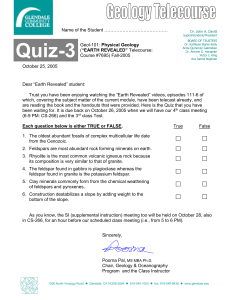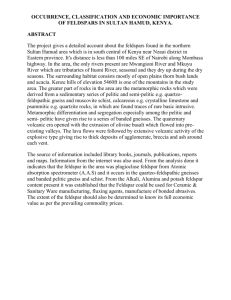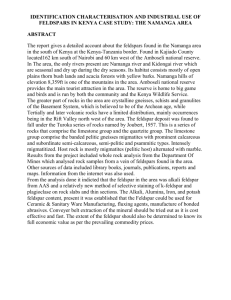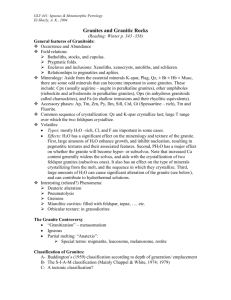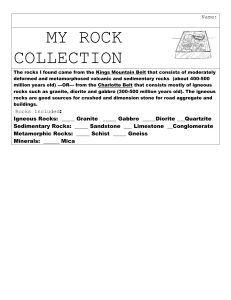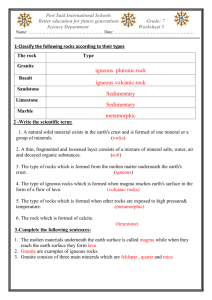12.109 Magmatic Processes
advertisement
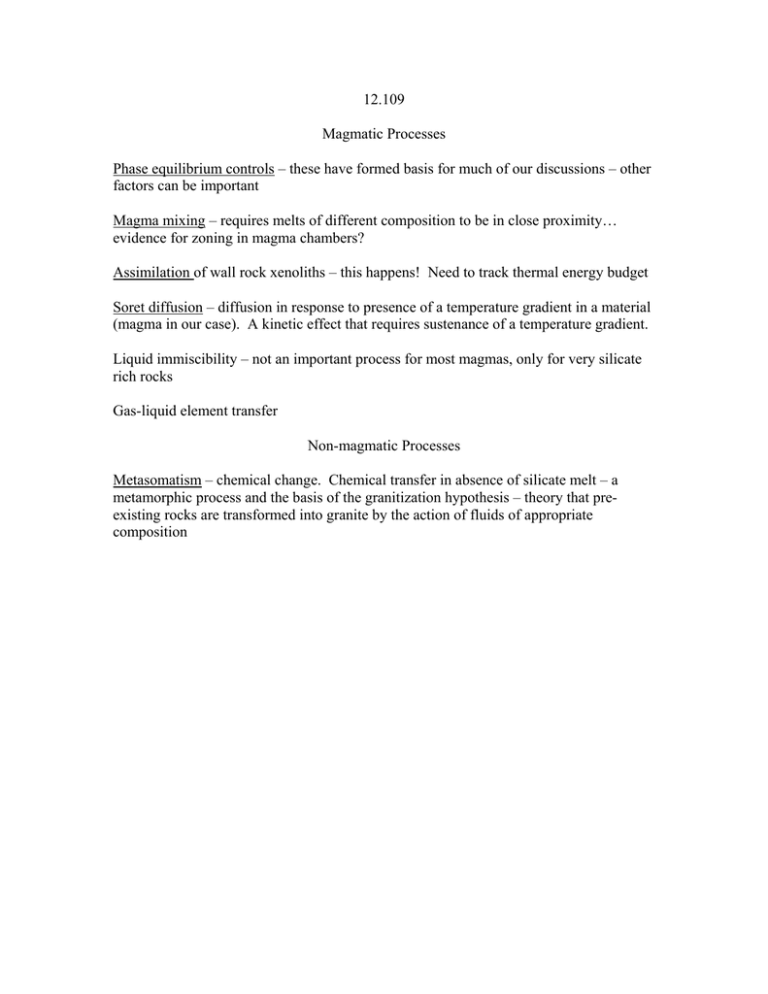
12.109 Magmatic Processes Phase equilibrium controls – these have formed basis for much of our discussions – other factors can be important Magma mixing – requires melts of different composition to be in close proximity… evidence for zoning in magma chambers? Assimilation of wall rock xenoliths – this happens! Need to track thermal energy budget Soret diffusion – diffusion in response to presence of a temperature gradient in a material (magma in our case). A kinetic effect that requires sustenance of a temperature gradient. Liquid immiscibility – not an important process for most magmas, only for very silicate rich rocks Gas-liquid element transfer Non-magmatic Processes Metasomatism – chemical change. Chemical transfer in absence of silicate melt – a metamorphic process and the basis of the granitization hypothesis – theory that preexisting rocks are transformed into granite by the action of fluids of appropriate composition Granitic rocks Historical perspectives on the granite problem Carmichael, Turner, and Verhoogen (1974) Igneous Petrology p. 593-596. Daly (1933) Igneous rocks and the depths of the earth Chap. XVII. Marmo (1967) Earth Sci Rev 3:7-29. Proposed origins of granite problem and misconceptions 1) Metasomatic granitization on a large scale without participation of a silicate melt… Origin by hydrothermal replacement or solid diffusion 2) Granites’ derivative liquids produced by fractional crystallization of basalt… Origin as magmatic liquids. 3) What are sources of magmas? Where are these located? 4) Enormous “granite” batholiths are not granite. Much of the plutonic rock is granodiorite – tonalite – quartz diorite. Tuttle and Bowen’s (1958) [GSA Memoir 74] experimental work distinguished between hypotheses 1) and 2). Bowen and Tuttle showed that the system Ab-Or-Qtz-H2O contained a ternary minimum and that all granites plotted near that minimum. The easiest way to produce such a clustering is by fractional crystallization. Today’s major granite problem is source for the large continental batholiths. Information contained in granitic rocks Compositions of spatially and temporally related granitic rocks may record a “liquid line of descent” at some P, T, and PH2O. Some strange textures in granites have also intrigued petrologists. Rapakivi = plagioclase feldspar overgrowths on alkali feldspar. Anti-rapakivi = alkali feldspar overgrowths on plagioclase. The proposals for the origin of these different textures center around the role of variable T, P, and H2O on the termination of the two feldspar + liquid (2 fsp + liq) boundary curve. Anti-rapakivi, the mantling of plagioclase by alkali feldspar, is found in many rocks… from absarokite to shoshonite to syenite (these are rocks with low aSiO2 and PH2O). Usually low-pressure environments. Experiments at low P show that the 2 fsp + liq curve lies on the alkali feldspar side of the solvus-solidus intersection. Therefore, one can explain the alkali feldspar rims on plagioclase as a consequence of low P fractional crystallization. This is the equivalent to a peritectic reaction, Plag + Liq = Kspar Sometimes (Often) there is no reaction overgrowth relation in two feldspar rocks. This observation is consistent with increasing aSiO2 and PH2O. Experimental results show that increases in H2O and SiO2 make the 2 fsp + liq boundary a cotectic. Rapakivi textures are harder to explain. Quartz is present in rapakivi associations. There is no evidence from phase relations that the 2 fsp + liq curve lies on the plag side of the solidus-solvus intersection under any P or aH2O conditions. The experiments show that the 2 fsp + liq boundary is either plagioclase peritectic or cotectic all the way. What is the explanation, then? Degassing – a decrease in PH2O causes the 2 fsp + liq boundary to move toward the alkali feldspar corner. This movement decreases the area of the alkali feldspar liquidus field, and a liquid on the 2 fsp + liq boundary at higher pressures will find itself in the plag primary phase volume after a pressure drop. An intriguing thought is that rapakivi granites may be the recorders of catastrophic silicic volcanic eruptions!
